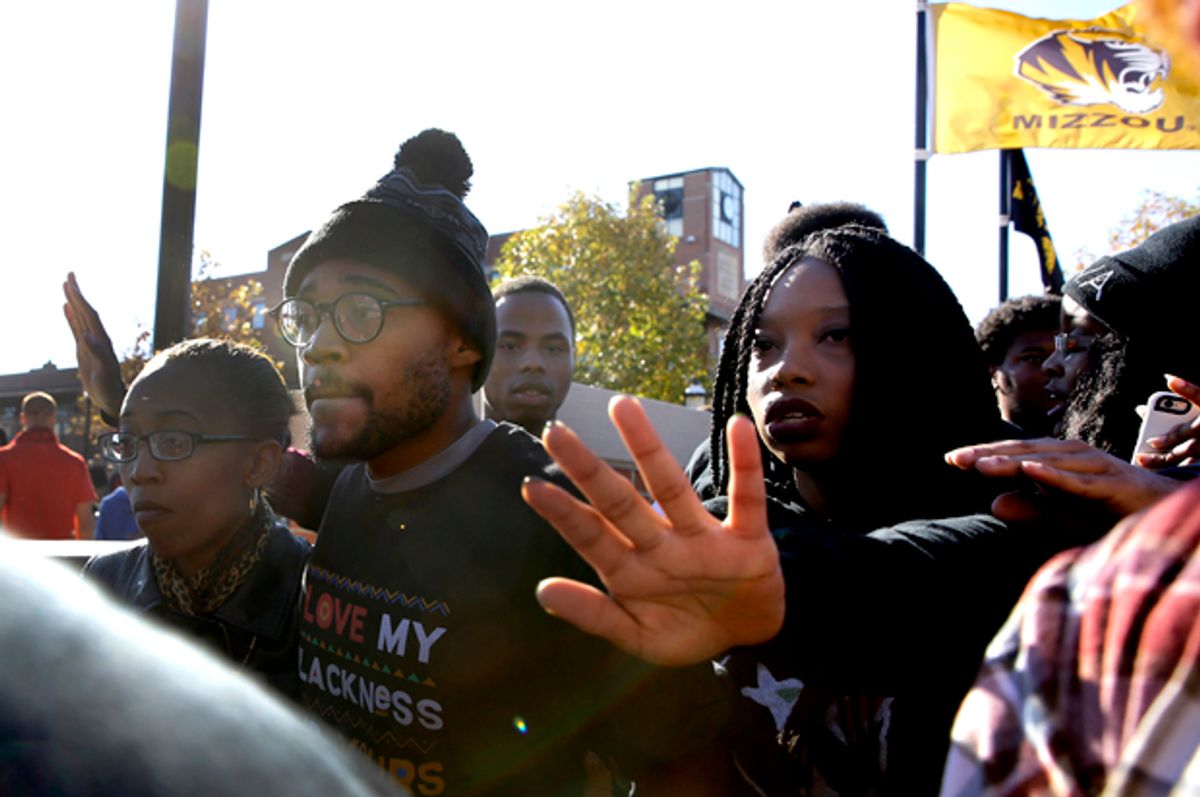Following the stunning resignations of president Tim Wolfe and chancellor R. Bowen Loftin in the wake of Black student activism at the University of Missouri-Columbia, a secondary news story is developing at the school. It is a meta-narrative about the way news gets made, who controls the telling, and how stories get framed. It is a bit about the First Amendment--and perhaps academic freedom too, insofar as activist faculty are involved. But it mostly is a story about distrust. About Black distrust of the White gaze, and an utter lack of faith in the capacity of a White press to tell Black stories with honesty.
The centerpiece of this new story at Missouri is a student of photojournalism, Tim Tai, 20. On assignment from ESPN to photograph historic events on campus, he turned his camera on an encampment that protesters had pitched on the university quad. For about a week, protesters had been camping out there to "protest and strategize," anonymous sources tell me. "But, until yesterday, the media had rarely showed up to interview the students."
All that changed with remarkable speed. After ignoring this story for months, hundreds of members of the press were suddenly everywhere on campus. "As the the president’s resignation announcement was unfolding," my sources relate, "the protesters decided to convene in their camp to discuss their strategy. But the journalists, of course, wanted to get an exclusive of the students’ reactions to the president’s resignation. As a consequence, the protesters--with the collaboration of other students, locals, and even faculty--decided to momentarily block the journalists’ access to the camp. In the heat of the moment, there may have been some pushback but, after the protesters convened, they invited the public, including the media, to a big party."
But it is Tai's confrontation with protesters that is making the news. And this focus itself requires examination. For by focusing on a young Asian man--a member of the so-called "model minority" on a big assignment--going head to head with Black protesters living in a "makeshift tent city," the coverage is already playing off racist stereotypes. But who is filming the confrontation? From whose perspective are these events being recorded? The videographer is a young journalist named Mark Schierbecker. Ostensibly viewed through a "neutral" mechanical eye recording things-as-they-occur, the limits of the camera's frame are nonetheless shaping what we see in a very particular way. It is framing it through the reflexive lens of whiteness.
As a reporter for KBIA (Mid-Missouri pubic radio) commented ruefully: "The demonstrator telling the photographer to back up is a black man. Other demonstrators nearby are white, black, men, women. The photographer appears to be Asian, though I didn't ask anyone how they identified. But, like me, most of the reporters there were white men." And this white maleness matters, Bram Sable-Smith concluded. For there is no way to avoid talking about race -- "not in a story about a demonstration against systematic oppression."
And yet hardly anyone is talking about race--specifically, the nearly monolithic whiteness of the media descending on the protesters' encampment. But you wouldn't know that from watching that video. Instead, it's focused on an Asian photographer trying doggedly to take photos by invoking his First Amendment rights to be in a public space, as Black student protesters and White women do their best to get rid of him. Tai is now doing his best to turn the spotlight back where it belongs: on the systemic problems on the Missouri campus that have led to historic events still unfolding. "I'm a little perturbed at being part of the story," he tweeted. "So maybe let's focus some more reporting on systemic racism in higher ed institutions."
This "unbearable whiteness of liberal media" is precisely why the Black student protesters asked journalists to please "respect" them as well as their space by leaving them alone, at least long enough to collect their thoughts. When Sable-Smith repeatedly asked for a statement, the students replied, again and again, joyfully: "To God be the Glory." He did not understand that response.
Journalist Tracie Powell runs the website All Digitocracy.org, which works to support journalists of color while raising awareness of structural racism in the media. Powell is concerned about the treatment of Tai, the student photographer, but her gut instinct was that the refusal of the protesters to admit the press was, more accurately, their refusal to feed the biases of White journalism. "For me, the overwhelming impression was that they didn't trust the White reporters suddenly trying to cover the story." In conversation with me, she noted that these reporters had already shown themselves to be ranging from indifferent to outright hostile to the concerns outlined by Black students on campus, and "parachute journalism"--jumping in to a big story and then leaving--would give activists no reason to trust them. Her instincts are confirmed from various tweets from student protesters on campus, including one from #ConcernedStudent1950: "It's typically white media who don't understand the importance of respecting black spaces."
It's not that Tai didn't find his First Amendment rights being challenged. He did. Protesters also put signs declaring "No Media/ Safe Space" zones, and refused to speak to the press. But these are not the nut of the story. The story is about the way local television news and other media outlets questioned and undermined the protesters’ reactions by turning the press itself into the victim. As one of my sources observed: "This is just a poor and dishonest attempt of portraying what was actually a huge victory in the name of justice. Unfortunately, this has been a frequently used tactic to discredit the efforts of those fighting against racism and other forms of oppression."
Meanwhile, a new sign has appeared on campus, identifying itself as being from #ConcernedStudent1950: "Media has a 1st Amendment right to occupy campsite, 2) the media is important to tell our story and experiences at Mizzou to the world. 3) Let's welcome and thank them."

Shares